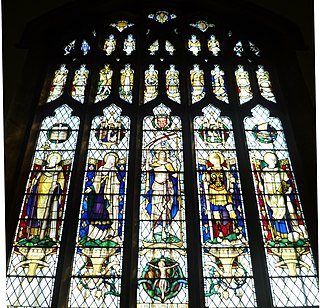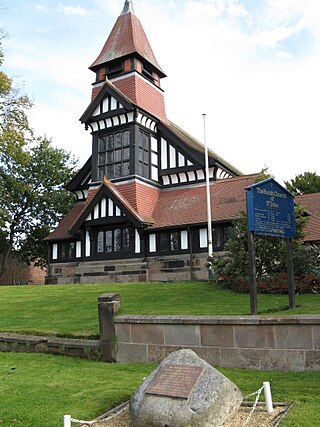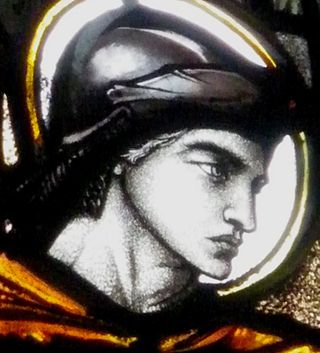
The Cathedral Basilica of Christ the King is a Roman Catholic church in Hamilton, Ontario, Canada. The cathedral was consecrated on December 19, 1933. It is the seat of the bishop of the Diocese of Hamilton, and the cathedral of the Diocese of Hamilton. The cathedral contains the cathedra of the bishop, the Most Rev. Douglas Crosby. The cathedral was raised to the status of a minor basilica in February 2013 by Pope Benedict XVI.

St. Michael's Church is an Anglican church in Brighton, England, dating from the mid-Victorian era. Located on Victoria Road in the Montpelier area, to the east of Montpelier Road, it is one of the largest churches in the city of Brighton and Hove. The church is a Grade I listed building.

All Saints Hove is an Anglican church in Hove, part of the English city of Brighton and Hove. It has served as the parish church for the whole of Hove since 1892, and stands in a prominent location at a major crossroads in central Hove.

Calvary Episcopal Church is a parish of the Episcopal Diocese of Pittsburgh, Pennsylvania. The parish was founded in 1855.

St Saviour's is an Anglo-Catholic church in Pimlico, City of Westminster, London, England, located at the north end of St George's Square. It was constructed in the 1860s as part of Thomas Cubitt's development of the area on behalf of the Marquess of Westminster. The church was designed by Thomas Cundy, who had previously built St Gabriel's Pimlico a short distance away. As with St Gabriel's, St Saviour's was designed in the Gothic style and built in ragstone to emphasise the contrast with the classical stucco of its secular neighbours. The church is Grade II listed.
The Church of the Incarnation is a parish of the Diocese of Dallas of the Episcopal Church, located at 3966 McKinney Avenue in Dallas, Texas.

Christopher Rahere Webb (1886-1966) was an English stained glass designer.

St Andrew the Apostle is an Anglican church in Worthing, West Sussex, England. Built between 1885 and 1886 in the Early English Gothic style by Sir Arthur Blomfield, "one of the last great Gothic revivalists", the church was embroiled in controversy as soon as it was founded. During a period of religious unrest in the town, theological tensions within Anglicanism between High church Anglo-Catholics and Low church Anglicans were inflamed by what the latter group saw as the church's "idolatrous" Roman Catholic-style fittings—in particular, a statue of the Virgin Mary which was seized upon by opponents as an example of a reversion to Catholic-style worship in the Church of England. The "Worthing Madonna" dispute delayed the consecration of the church by several years. English Heritage has listed the building at Grade C for its architectural and historical importance, and the adjacent vestry and vicarage are listed separately at Grade II.

Henry E. Sharp was a nineteenth-century American stained glass maker active with William Steele from c.1850 to c.1897.

St Mary's Church is a redundant Anglican church in St Mary's Place, Shrewsbury, Shropshire, England. It is recorded in the National Heritage List for England as a designated Grade I listed building, and is under the care of the Churches Conservation Trust, the Trust designated St Mary's as its first Conservation Church in 2015. It is the largest church in Shrewsbury. Clifton-Taylor includes the church in his list of 'best' English parish churches.

St John's Church is an active Anglican parish church in the village of High Legh, Cheshire, England. It is in the deanery of Knutsford, the archdeaconry of Macclesfield and the diocese of Chester.
St Peter's Church is in Earle Street, Crewe, Cheshire, England. It is an active Anglican parish church in the deanery of Nantwich, the archdeaconry of Macclesfield, and the diocese of Chester. Its benefice is combined with that of All Saints and St Paul, Crewe. The church is recorded in the National Heritage List for England as a designated Grade II listed building.

St. Mary's Church, Horncastle, Lincolnshire, England, dates from the early 13th century and is dedicated to Saint Mary. It serves the Ecclesiastical Parish of Horncastle and a grade II* listed building that was heavily restored by Ewan Christian between 1859 and 1861.

Rachel de Montmorency, née Rachel Marion Tancock, was an English painter and artist working in stained glass. She learned about stained glass when she worked for artist Christopher Whall in the 1910s and 1920s. During World War I she worked as a voluntary nurse.

St Catherine of Siena Church is an Anglican parish church in Cocking, a village in the district of Chichester, one of seven local government districts in the English county of West Sussex.

The Church of St Cuthbert by the Forest is in the village of Mouldsworth, Cheshire, England. It is an active Roman Catholic church in the diocese of Shrewsbury. Its parish is combined with that of St Thomas Becket, Tarporley. The church, designed by Liverpool architect F. X. Velarde, is recorded in the National Heritage List for England as a designated Grade II listed building. The small church is distinguished by its characteristic detached campanile.

St Joseph's Church is in York Road, Birkdale, Southport, Sefton, Merseyside, England, and is an active Roman Catholic church in the diocese of Liverpool. It was designed by E. W. Pugin, and built in 1865–67 with an aisle added in 1875. The church is recorded in the National Heritage List for England as a designated Grade II listed building.

St Peter's Church is a Catholic church in Woolwich, South East London. It is situated between Woolwich New Road and Brookhill Road, the main entrance being on Woolwich New Road. The church was designed by Augustus Pugin in 1841–42 in the style of the Gothic Revival and is one of only three Pugin churches in London. Pugin's design remained unfinished as the projected tower and spire were never built. The parish of St Peter the Apostle serves the Catholic community of central Woolwich and surrounding areas, and is part of the Archdiocese of Southwark which is in the Province of Southwark.

St George's Anglican Church, also known as Iglesia Anglicana-Episcopaliana de San Jorge or, simply Capilla Británica, is a small Anglican church located in the barrio of Recoletos, district of Salamanca, Madrid, Spain, which belongs to the Diocese in Europe of the Church of England. The church was built in 1923 and was consecrated in March 1925.

The St. Catherine of Alexandria Church is a Roman Catholic church in the Tabán quarter of Budapest, Hungary. It is the parish church of the Tabán Parish which also comprises parts of Gellért Hill and Naphegy. The church is a listed monument that was built in Central European Baroque style between 1728 and 1777. It was reconstructed several times in the 19th–20th centuries.





























